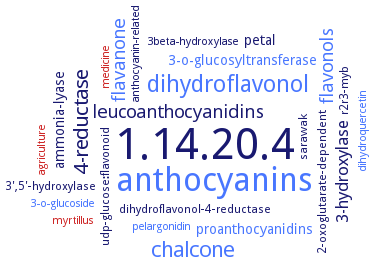1.14.20.4: anthocyanidin synthase
This is an abbreviated version!
For detailed information about anthocyanidin synthase, go to the full flat file.

Word Map on EC 1.14.20.4 
-
1.14.20.4
-
anthocyanins
-
dihydroflavonol
-
chalcone
-
4-reductase
-
flavanone
-
flavonols
-
leucoanthocyanidins
-
3-hydroxylase
-
ammonia-lyase
-
3-o-glucosyltransferase
-
petal
-
proanthocyanidins
-
dihydroflavonol-4-reductase
-
3',5'-hydroxylase
-
udp-glucose:flavonoid
-
sarawak
-
r2r3-myb
-
2-oxoglutarate-dependent
-
myrtillus
-
3-o-glucoside
-
dihydroquercetin
-
pelargonidin
-
3beta-hydroxylase
-
agriculture
-
anthocyanin-related
-
medicine
- 1.14.20.4
- anthocyanins
- dihydroflavonol
- chalcone
-
4-reductase
- flavanone
- flavonols
-
leucoanthocyanidins
-
3-hydroxylase
-
ammonia-lyase
- 3-o-glucosyltransferase
- petal
- proanthocyanidins
- dihydroflavonol-4-reductase
-
3',5'-hydroxylase
-
udp-glucose:flavonoid
-
sarawak
-
r2r3-myb
-
2-oxoglutarate-dependent
- myrtillus
- 3-o-glucoside
- dihydroquercetin
- pelargonidin
-
3beta-hydroxylase
- agriculture
-
anthocyanin-related
- medicine
Reaction
Synonyms
ANS, ANS-1, ANS-2, anthocyanidin synthase, anthocyanidin synthase 1, anthocyanidine synthase, anthocyanin synthase, FcANS1, GbANS, IbANS, LDOX, leucoanthocyanidin dioxygenase, leucoanthocyanidin oxygenase, leucocyanidin dioxygenase, leucocyanidin oxygenase, leucocyanidin,2-oxoglutarate:oxygen oxidoreductase, McANS-1, McANS-2, MdANS, RtLDOX
ECTree
Advanced search results
Systematic Name
Systematic Name on EC 1.14.20.4 - anthocyanidin synthase
Please wait a moment until all data is loaded. This message will disappear when all data is loaded.
(2R,3S,4S)-leucoanthocyanidin,2-oxoglutarate:oxygen oxidoreductase
The enzyme requires Fe(II) and ascorbate. It is involved in the pathway by which many flowering plants make anthocyanin flower pigments (glycosylated anthocyandins). The enzyme hydroxylates the C-3 carbon, followed by a trans diaxial elimination, forming a C-2,C-3 enol. The product loses a second water molecule to form anthocyanidins. When assayed in vitro, non-enzymic epimerization of the product can lead to formation of dihydroflavanols. Thus when the substrate is leucocyanidin, a mixture of (+)-taxifolin and (+)-epitaxifolin are formed. The enzyme can also oxidize the formed (+)-taxifolin to quercetin (cf. EC 1.14.20.6, flavonol synthase) [2,3].


 results (
results ( results (
results ( top
top





